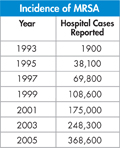Analyzing Data
MRSA on the Rise
Infection by methicillin-resistant Staphylococcus aureus (MRSA) can spread very quickly in hospitals and nursing homes. The table at right shows the incidence of MRSA infections in U.S. hospitals during a 13-year period.
Graph Prepare a line graph showing the number of MRSA infections in U.S. hospitals over time. Describe the trend shown.
Calculate By what percentage did MRSA infections in U.S. hospitals increase between 1995 and 2005?

Draw Conclusions A 2007 study reported that the average hospital stay in the United States lasted 4.6 days, while that of the average MRSA-infected patient was 10.0 days. If the trend shown by the data above continues, what effect will MRSA infections have on future hospital costs?
“Superbugs” When first introduced in the 1940s, penicillin, an antibiotic derived from fungi, was a miracle drug. Patients suffering from life-threatening infections were cured almost immediately by this powerful new drug. Conquest of bacterial diseases seemed to be in sight. Within a few decades, however, penicillin lost much of its effectiveness, as have other, more current antibiotics. The culprit is evolution.
The widespread use of antibiotics has led to a process of natural selection that favors the emergence of resistance to these powerful drugs. Physicians now must fight “superbugs” that are resistant to whole groups of antibiotics and that transfer drug-resistant genes from one bacterium to another through conjugation.
An especially dangerous form of multiple drug resistance has recently appeared in a common bacterium. Methicillin-resistant Staphylococcus aureus, known as MRSA (pronounced MURS uh), can cause infections that are especially difficult to control. MRSA skin infections can be spread by close contact, including the sharing of personal items such as towels and athletic gear, and can often spread in hospitals, where MRSA bacteria can infect surgical wounds and spread from patient to patient.

FIGURE 20–20 MRSA Methicillin-resistant S. aureus is a bacterium that is resistant to methicillin and other common antibiotics.
New Viruses Because viruses replicate so quickly, their genetic makeup can change rapidly, sometimes allowing a virus to jump from one host species to another. Researchers have evidence that this is how the virus that causes AIDS originated, moving from nonhuman primates into humans.
Public health officials are especially worried about the flu virus. Gene shuffling among different flu viruses infecting wild and domesticated bird populations has led to the emergence of a “bird flu” that is similar in many ways to the most deadly human versions of flu. In a few isolated cases, bird flu has indeed infected humans, and health officials warn that a major “jump” into the human population remains possible in the future.

Table of Contents
- Formulas and Equations
- Applying Formulas and Equations
- Mean, Median, and Mode
- Estimation
- Using Measurements in Calculations
- Effects of Measurement Errors
- Accuracy
- Precision
- Comparing Accuracy and Precision
- Significant Figures
- Calculating With Significant Figures
- Scientific Notation
- Calculating With Scientific Notation
- Dimensional Analysis
- Applying Dimensional Analysis





